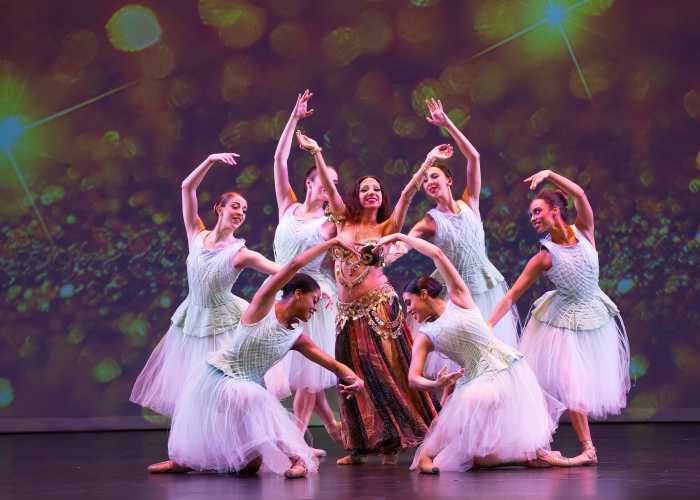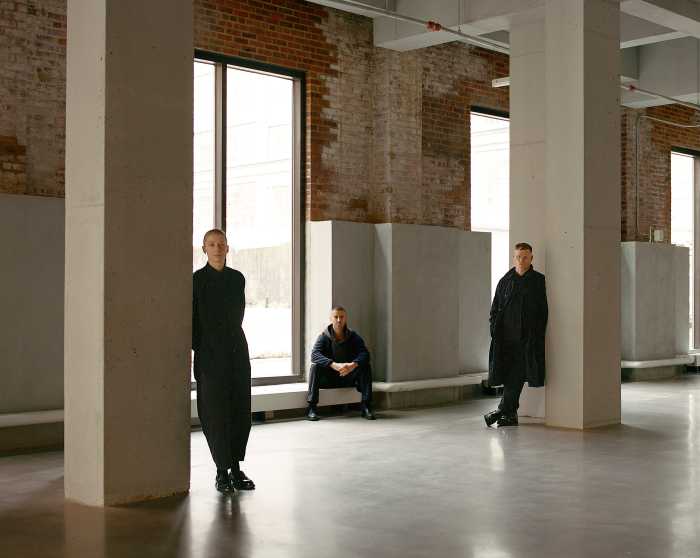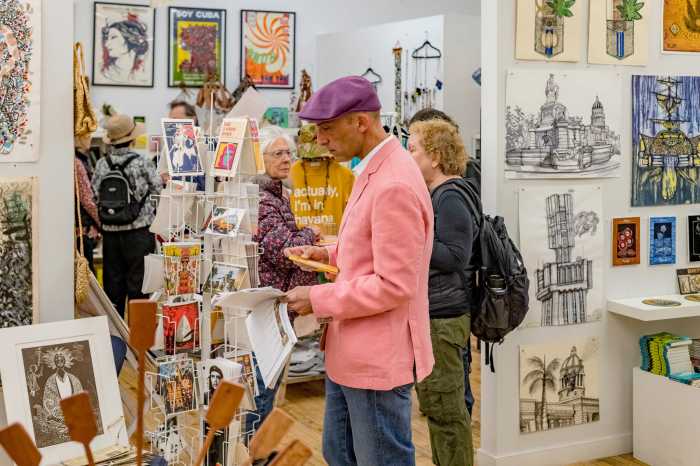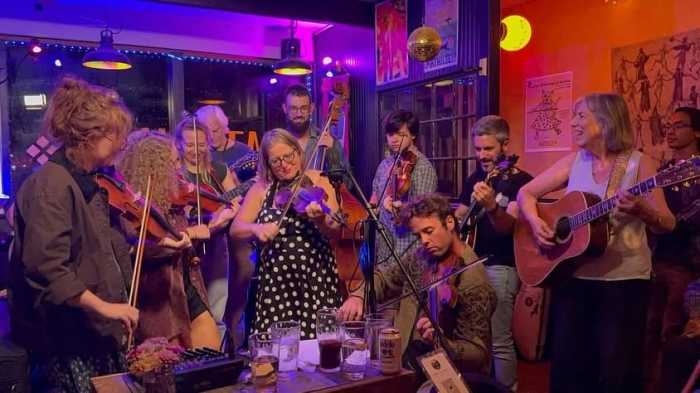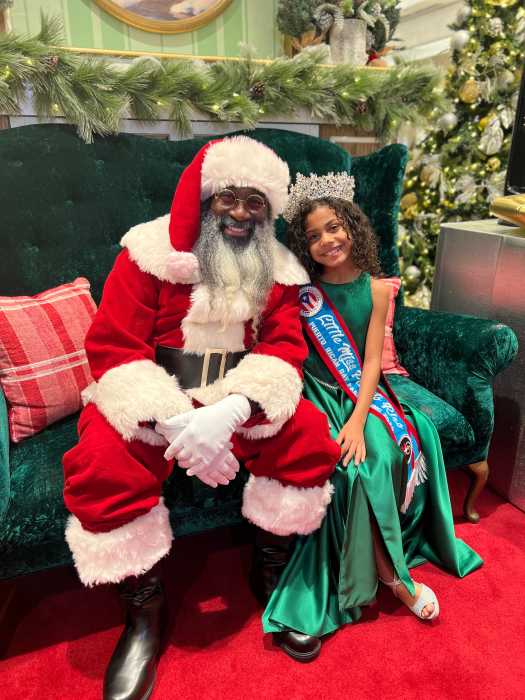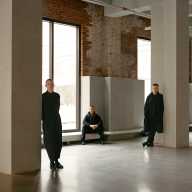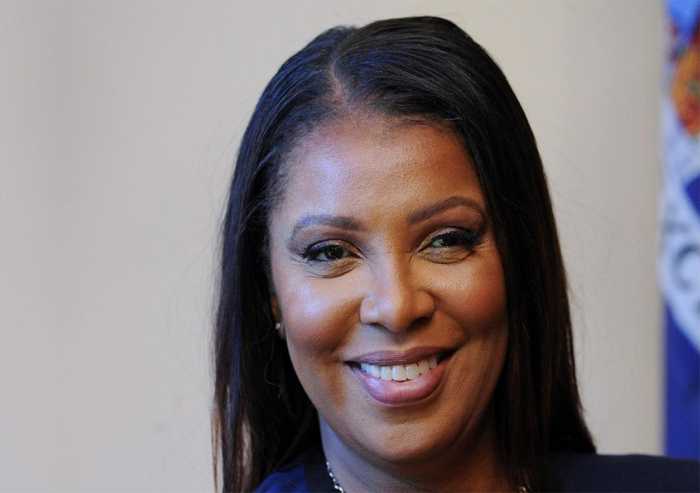A new photography exhibit on display at
the Downtown Brooklyn campus of Long Island University, "Jews
of Brooklyn," reflects the broad range of Jewish life in
the borough’s neighborhoods from the 1940s to the present. It
combines the work of prominent photographers such as Arthur Leipzig,
Jerry Dantzic and Harvey Wang alongside emerging photographers.
LIU professors Stuart Fishelson, Jan Rosenberg, Rodney Hurley
and Nancy Grove curated the show together with Ilana Abramovitch,
co-editor of the collection of essays, "Jews of Brooklyn"
(Brandeis University Press), which was released earlier this
month.
Rosenberg, a sociology professor, told GO Brooklyn Tuesday that
photographs by New York Photo League students Ruth Orkin (1921-1985)
and her husband, Morris Engel, in addition to photos by Dantzic
and Leipzig, will also be included in the exhibit. (Orkin’s most
famous – and controversial – image is "American Girl in
Italy," 1951, in which a woman walking in the Piazza del
Republica attracts the attention of men of all ages.)
GO Brooklyn got a sneak peek of "Jews of Brooklyn"
this week before it opens officially on Feb. 6 with an artists’
reception.
Spanning religious and secular subjects, "Jews of Brooklyn"
currently includes photos of children at play and at prayer,
adults at a wedding and a bar mitzvah, as well as a smattering
of insightful portraits: a grave digger, matzoh bakers and a
seamstress.
Rosenberg believes the photos speak for themselves, but that
viewers, especially of other cultural backgrounds, would certainly
be enlightened if the curators took the opportunity to post explanatory
text, or even just a brief glossary, defining terms used in the
captions.
The show includes Leipzig’s iconic black-and-white images of
boys playing in Brooklyn streets, such as "Hide and Seek"
(1943), in which a gaggle of boys hide under a car, and a girl
peers around the car, curious about all the fuss being made.
Photos from this photojournalist’s book "Growing Up in New
York: Photographs" (David R. Godine, 1995), depicting children
at play, have been exhibited widely, including a 1996 solo show
at the Museum of the City of New York.
Emerging photographer Melanie Einzig’s colorful photo "Purim,
Williamsburg" (2000), captures two boys sitting on the top
step of a stoop, wearing crowns – costumes in celebration of
the ancient holiday commemorating the deliverance of the Jews
from massacre by the evil Haman.
Fishelson’s "Wandering Jew" (1986) depicts a small
boy dragging a baby carriage around on a beach. Fishelson, an
LIU professor of media arts, has made his subject more lighthearted
by the pun of the title. Similarly cutesy is Einzig’s "Sukkot,
Borough Park" (2001), a portrait of a cherubic boy caught
with a mouthful of pink cotton candy against a backdrop of carnival
games.
Sukkot, explains Rabbi Aaron Raskin of Congregation B’nai Avraham
in Brooklyn Heights, is often a time when parents take advantage
of the kids’ time off from school to enjoy family outings at
Coney Island’s Astroland Park or the circus.
Jerry Dantzic’s "Torah is Forever (L’ag B’omer parade),
Crown Heights" (1973) shows children behind a barricade
holding placards that read "Torah is forever," "We’re
from Canarsie" and "We’re from Boro Park." This
auspicious event, as explained by Raskin, is filled with "tremendous
joy" commemorating the end of a plague 2,500 years ago.
The parade attracts Jews from well beyond Brooklyn’s borders,
he said.
Interestingly, Dantzic’s composition, photographing the children
partially obstructed by barricades, is open to many interpretations.
Are the children being penned in? Or will their numbers soon
overflow the barricades? Are they isolated from the world beyond
the barricade by their own people or by those from outside the
barricade? Can the Torah set these children free? Dantzic’s photo
is truly gripping.
Photographs by Michael Macioce are quite a departure from these
naive, innocent children at play. His photographs, taken with
black-and-white infrared film, inject a mystical aspect to his
subject matter of Jewish rituals by lending the prints a soft-focus,
grainy quality.
In Macioce’s "Kaddish," the subject is a man with head
bent in prayer, his hand bound with the leather band of the tefillin.
His hour of darkness contrasts with the softly glowing light
of the candles in front of him. The word "kaddish"
is Hebrew for a prayer that is recited in the daily synagogue
services and by mourners after the death of a close relative,
Macioce’s "Shabbis" depicts a triangle of women, two
young girls with their hands covering their eyes, giving the
blessing on the eve of the sabbath, while an adult woman towers
over them. According to Raskin, the lighting of the candles by
the girls brings peace and tranquility into the home. It is an
auspicious time for a woman, explains Raskin, when God listens
to her prayer.
Macioce’s soft focus in this photo accentuates the gleaming beauty
of the upper class home and the regal bearing of the woman.
There are also several photos by photographer-filmmaker Harvey
Wang. A widely published photographer, his collections include
"Harvey Wang’s New York" (W.W. Norton & Co., 1990),
"Holding On: Dreamers, Visionaries, Eccentrics and Other
American Heroes" (W.W. Norton & Co., 1996), and "Flophouse,
Life on the Bowery" (Random House, 2000). Wang’s 1998 film
"Vilna" had its premiere at the New York Jewish Film
Festival at the Film Society of Lincoln Center.
Among Wang’s photos on display there is a portrait of an ancient
man holding matzoh, with piles of cordwood behind him, presumably
the fuel for a brick oven. His aged, creased face and long, white
beard contrasting with his black yarmulke, reflect the history
behind the tradition of making the matzoh, which he holds in
pristine paper.
Some photos emphasize the different ways men and women experience
Judaism. Emerging photographer Shalhevet Moshe’s gloriously colorful
series of photographs depict a Yeminite henna ceremony shot in
Mill Basin in October. An elaborate, gorgeous headress is placed
on a delighted woman by the dresser, Shoshanna Tubi.
For another, completely different view of the Jewish woman’s
experience, Miriam Rubinoff’s somber black-and-white photo "Girls
and Women at Bar Mitzvah" (1995) has an interesting title.
Three adult women are photographed from behind, peering at the
ceremony through a lattice. To their right, three little girls
dressed in their flowered frocks sit on the floor together. Both
generations are made into voyeurs by their exclusion – while
the viewer watches them.
In addition to these works taken by professional – and some quite
famous – photographers, Rosenberg said, that scans of vernacular
photos, or family photographs, will also be added to the exhibit
in a collage with some text.
"Jews of Brooklyn" will be
on display Feb. 6 through Feb. 28 at Long Island University’s
Salena Gallery at the intersection of DeKalb Avenue and Flatbush
Avenue Extension.
On Feb. 6, author Andre Aciman will speak on "The Meaning
of Memory and Place" place from 3:30-4:30 pm at the Library
Learning Center, Room 122 (adjacent to the Salena Gallery). From
4:30 pm to 5:30 pm, photographer Arthur Leipzig will give a slide
lecture on his decades-long project of photographing Jews around
the world. The opening reception, featuring klezmer music by
Peter Sokolow, is from 5:30 pm to 7:30 pm.
Gallery hours are Monday through Friday, 9 am to 6 pm and Saturday
and Sunday, 11 am to 5 pm. The exhibit is free and open to the
public. For more information, call (718) 488-1052.



